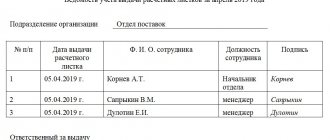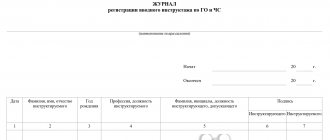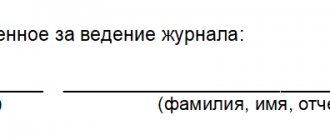What kind of occupational safety magazines are there?
The legislation of the Russian Federation in the field of labor protection (Labor Code of the Russian Federation, GOST 12.0.004-90, Decree of the Ministry of Labor of the Russian Federation dated December 17, 2002 No. 80) requires Russian employers to keep logs:
- registration of introductory briefings on labor protection (clause 7.1.5 GOST 12.0.004-90);
- registration of labor safety briefings that are not introductory (clause 7.9 of GOST 12.0.004-90);
- taking into account instructions on labor protection (clause 5.10 of the appendix to the resolution of the Ministry of Labor of the Russian Federation dated December 17, 2002 No. 80);
- accounting for the issuance of instructions on labor protection (clause 5.10 of the appendix to the resolution of the Ministry of Labor of the Russian Federation dated December 17, 2002 No. 80);
- registration of accidents (Article 230.1 of the Labor Code of the Russian Federation).
These registers are the main journals on labor protection at Russian enterprises.
We will prepare for you a complete list of labor protection documents that an employer must have
“Type of briefing (primary, repeated, unscheduled, targeted)” (column No. 5).
| Briefing | When do we do it? |
| primary | before the start of production activities, after the employee has received introductory instructions on labor protection. |
| repeated | at least once every six months (in fact, we repeat the initial briefing at the workplace), unless other deadlines and frequency are specified by industry and cross-industry regulatory legal acts that apply to the activities of your organization. For example, driver Ivanov I.I. undergoes repeated instruction once every 3 months (clause 10.10 of the Resolution of the Ministry of Labor of the Russian Federation of May 12, 2003 N 28 “On approval of Inter-industry rules for labor protection in road transport”). Regulate the frequency of repeated briefings by order of the organization (for example, in the same order “On conducting briefings on labor protection”). At the same time, if some of the employees of one division must undergo training once a quarter, and another part - once every six months, you can establish repeated instructions once a quarter for all employees of this division, since this does not contradict the current legislation and will allow the person responsible for Conducting briefings for this unit will not cause confusion. |
| unscheduled |
|
| target | when performing one-time work, when eliminating the consequences of accidents, natural disasters and work for which a permit, permit or other special documents are issued, as well as when holding mass events in the organization. |
“The reason for conducting an unscheduled, targeted briefing” (column No. 6).
Possible reasons listed in clauses 7.4.1, 7.5.1 of GOST 12.0.004-90. Interstate standard. System of occupational safety standards. Organization of occupational safety training. General provisions”, paragraphs 2.1.6-2.1.7 of the Resolution of the Ministry of Labor of the Russian Federation, the Ministry of Education of the Russian Federation dated January 13, 2003 N 1/29 “On approval of the Procedure for training in labor protection and testing knowledge of labor protection requirements for employees of organizations”, we have already indicated in the table above, they can be briefly formulated as follows:
| unscheduled | “introduction of new instructions on labor protection”, “change in technology”, “replacement of equipment”, “violation of labor protection requirements”, “accident”, “Act No. on an industrial accident”, “work interruption”, etc. . |
| target | “accident response”, “territory cleaning”, “work at height”, “welding work”, etc. |
“Information about on-the-job internships” (Columns No. 11-13). The employer is obliged to conduct an internship for employees entering work with harmful and (or) dangerous working conditions (Article 225 of the Labor Code of the Russian Federation), and the requirement for an internship may be contained in regulatory legal acts in the field of labor protection. The employer determines the duration of internship shifts independently (from 2 up to 14 shifts), based on the qualifications and work experience of the employee, the nature of the work performed. It is worth noting that in addition to an entry in the Journal for the internship, you also need: an internship program, an order for the employee’s internship, an order for the admission of this employee to independent work (if successful completion of the internship), a local regulatory legal act that contains the procedure for the internship, the features of conducting the internship in your organization.
Who is responsible for maintaining labor safety logs?
By separate orders of the company management, those responsible for maintaining:
- both types of briefing logs;
- accident register.
The competence of persons appointed by management to be responsible for maintaining these labor safety logs includes:
- timely entry of necessary information into them;
- prompt provision of occupational safety journals for use by other specialists, as well as their subsequent acceptance back for storage.
Regarding log books and issuing instructions, management can also appoint an employee responsible for maintaining and storing them. If the document is developed for a specific structural unit of the company, its storage should be carried out by the head of this unit.
Responsible person: compilation and maintenance
Control is assigned to many levels, but only one is involved in compilation and maintenance. An example of a magazine can be found below and downloaded in Word format for free.
The forms, which are uniform for all structural divisions of the enterprise, are stored in one place and by one person - an occupational safety and health engineer. In small companies, such duties are assigned to any other employee, and a corresponding order is issued. The responsible person is obliged to keep a log in accordance with the following rules:
- numbering of all pages;
- firmware certified by management;
- presence of the signature and seal of the manager;
- A stationery book with an A4 format spread is used for maintenance;
- the working field consists of 12 line columns;
- if the entry is very long, then multiple lines are allowed;
- dashes are entered in empty columns;
- the cover and paper must be wear-resistant, since the document is designed for long-term use and permanent storage.
Important! Large enterprises most often order such forms from a printing house, although they can be printed according to the example given.
Specifics of filling out occupational safety logs
Now let’s look at what nuances an employer should pay attention to when filling out occupational safety logs.
For both types of training logs, it is important to pay attention to:
- the presence of signatures of the person being instructed and the person instructing opposite each entry on the instruction;
- indication of the full name and positions of the instructed employee and instructor, the date of each briefing.
To fill out the instruction logbook, the following are of greatest importance:
- correct indication of the date of registration of the instruction and the beginning of its use;
- correct title of documents;
- presence of signatures of the responsible employee confirming the fact of acceptance of the instructions for registration.
With regard to the instruction log, special attention should be paid to:
- correct indication of the date of issue of instructions upon request;
- indication of the full name of the employees receiving instructions, as well as the presence of their signatures.
When filling out the accident log, it is important to indicate:
- the exact date, time, location of the incident;
- all necessary information about the victim;
- measures taken to eliminate the causes of the accident.
These nuances of filling out occupational safety logs are among the most critical. This does not mean that other columns or paragraphs of the document need not be filled out at all. It is also necessary to work with them, but errors or omissions of entries in them may not be as critical as in the elements of occupational safety journals reflected above.
INTRODUCTION REGISTRATION LOG
Logbook for issuing labor safety instructions
JOURNAL OF REGISTRATION OF INSTRUCTIONS AT THE WORKPLACE
JOURNAL of recording instructions on labor protection for workers
JOURNAL of registration of accidents at work
Fire safety briefing log
One of the most important parts of an enterprise’s fire safety policy is training personnel in the rules of behavior to exclude or eliminate fire hazardous situations. Information about the training conducted is recorded in a separate fire safety briefing log.
General information about training
The first safety briefing is carried out in conjunction with other types of briefings directly upon hiring. At its core, it is theoretical and practical training in the fundamentals that help personnel maintain safe conditions when performing work functions. Without a mark on its completion, an employee cannot be allowed to perform work. At the same time, instruction is not a one-time thing; over time or for objective reasons (for example, when changing equipment or introducing new technologies), it can be repeated several times.
The briefing can be carried out individually or in a group; all employees who have completed it must attest to this fact in the safety briefing log.
The duration of the briefing is determined on a case-by-case basis.
Failure to comply with safety rules by an employee gives the organization's management the right to apply one of the forms of disciplinary action to him (a reprimand, a reprimand, or even dismissal - in particularly difficult cases). In addition, if the employer suffered material damage as a result of the violation, he also has the right to recover compensation from the subordinate.
Why do you need a fire safety training log in the workplace?
Mastering the theoretical part of safety precautions at an enterprise is a prerequisite for admitting a newly arrived employee to his workplace. In addition to introductory training, other types of classes are provided for employees, depending on their length of service at the enterprise or other special conditions. There are a total of 5 types of training for staff:
- - introductory;
- - primary;
- - repeated;
- — target;
- - planned.
It is unacceptable to treat filling out the instruction registration book as a mere formality. Indeed, in the event of an emergency at the enterprise, it will confirm that training sessions were conducted with employees. And any inspection by the fire department will first require a log.
The manager or person responsible for safety is responsible for the timeliness and correctness of filling out the log. The authorized employee must have perfect knowledge of the discipline being taught and have experience working at the enterprise in question. In addition, he is required to have personal qualities that will help ensure a safe environment in the enterprise.
Important! Often, upon arrival to a new position, an employee undergoes simultaneously training in fire safety and labor protection. In such a situation, appropriate entries in separate journals are necessary.
Fire safety: what instructions are required
Several types of instructions are provided. The differences are in time, place, timing.
Introductory fire safety briefing
It is passed by everyone who entered the territory of the enterprise for the purpose of employment or concluding a cooperation agreement. The head of the organization (dedicated unit, branch) or a person vested with the appropriate authority is personally responsible for conducting induction training.
Initial fire safety training
The applicant passed interviews, preliminary tests and was allowed to work. Before he turns on the machine or personal PC, or picks up the phone, he is required to undergo initial instruction.
The immediate supervisor of the employee is required to do this. The lists of people responsible for departments, departments, workshops are approved by the head of the enterprise by his order.
Re-briefing
12 months after the initial training, the employee undergoes repeated training. The goal is to consolidate previously acquired knowledge. Heads (chiefs) of departments are required to conduct repeated briefings.
Important exception. If there is a real threat of explosion or fire in production, repeated instructions are carried out after 6 months.
Unscheduled fire safety briefing
The legislation provides that in certain situations, company employees must be sent to unscheduled training.
Reasons:
- new regulations related to fire safety have been adopted or current regulations have been adjusted;
- the enterprise switched to working with new technology, raw materials, starting materials, and tools;
- a fire occurred as a result of non-compliance with current fire safety requirements;
- State supervision authorities have established that employees of a legal entity do not know at all or know, but to an insufficient extent, fire safety requirements;
- the employee has not worked in his position for more than 60 calendar days (30 for hazardous industries);
- Information has been received that fires and explosions, including casualties, have been recorded in factories and companies with a similar production cycle and technology.
It is not the heads of departments who are responsible for conducting unscheduled briefings, but directly the head of the entire organization or a person appointed by him.
Targeted briefing
If an employee is involved in performing one-time work related to fire, he is required to undergo targeted training. It is also carried out if:
- personnel will have to eliminate the consequences of a man-made disaster, explosion, fire;
- it is necessary to carry out some work in a room with explosive conditions on the basis of a work permit;
- tourists are brought into the workshop;
- company employees are invited to participate in a mass event (from 50 people).
The person who needs the work or the organizer of the event should talk about safety measures in this case.
Fire safety induction log form
To ensure that the responsible employee does not have problems with the inspection authorities, it is important to learn how to fill out the logbook for the introductory fire safety briefing.
Traditionally, each page of such a book contains a table with columns:
- — Date of instruction;
- — Full name of the employee who attended the instruction;
- — year of birth of the person being instructed;
- — the position of the listener;
- — type of instruction;
- — Full name of the instructor;
- — signatures of participants.
Before you start filling out the log, it is important to make sure that it meets the following requirements:
- Convenient firmware. The sheets must be stitched with thin lace or thread. It is important to make sure that all pages open comfortably and that the text is completely readable.
- Seal. After stitching the book, the ends of the lace are glued to the cover along with a special sticker. It indicates the number of sheets in the magazine, the lacing date and information about the responsible employee. After the glue has dried, a stamp is placed on the sticker and part of the cover.
- Numbering. Page counting can start from the cover or from the first page with a table. For numbering, a pen, a stamp, or a printout can be used. The main thing is that the page numbers are indicated before using the book.
Control over the lead
The head of the unit checks the safety log daily, regardless of whether there are new entries or not. This is the first degree of control. The head of the labor protection department is also responsible; he must check its registration. In his job description, this form of control is listed as monthly. Moreover, the journal must contain his visa regarding the presence or absence of violations of conduct. Even the CEO should check the log once a quarter. This is the last stage of control. If everyone responsible knows how the document should be filled out correctly and controls its maintenance, there will be no problems with inspection authorities and no penalties.
Rules for filling out the logbook for fire safety briefings
The legislation establishes strict standards for filling out and maintaining current logs, as well as storing archival documents.
When filling out the pages of the journal, it is prohibited:
Legal norms
By law, the requirement to maintain a safety log applies to every employer. He is required to be present at production, in the office and when carrying out new work on other equipment. The fact that the employee is aware of the safety rules is indicated in the form, which is confirmed by his personal signature. The form of this form must comply with GOST.
Important! After filling out the log, it must be handed over to the archive, where it is stored permanently.
Particular attention is paid to maintaining, filling out and storing such a document in hazardous industries where there is a risk of injury and disfigurement. If an employee is not given introductory, repeated or other types of training, and he is injured or even killed, the employer will face a large fine and even criminal liability. Of course, it is important to register that the training has been completed; for this in 2022, as in previous years, a signature from the employee is required in the log. It is also important to observe the frequency of briefings and the rules for maintaining the journal itself.










